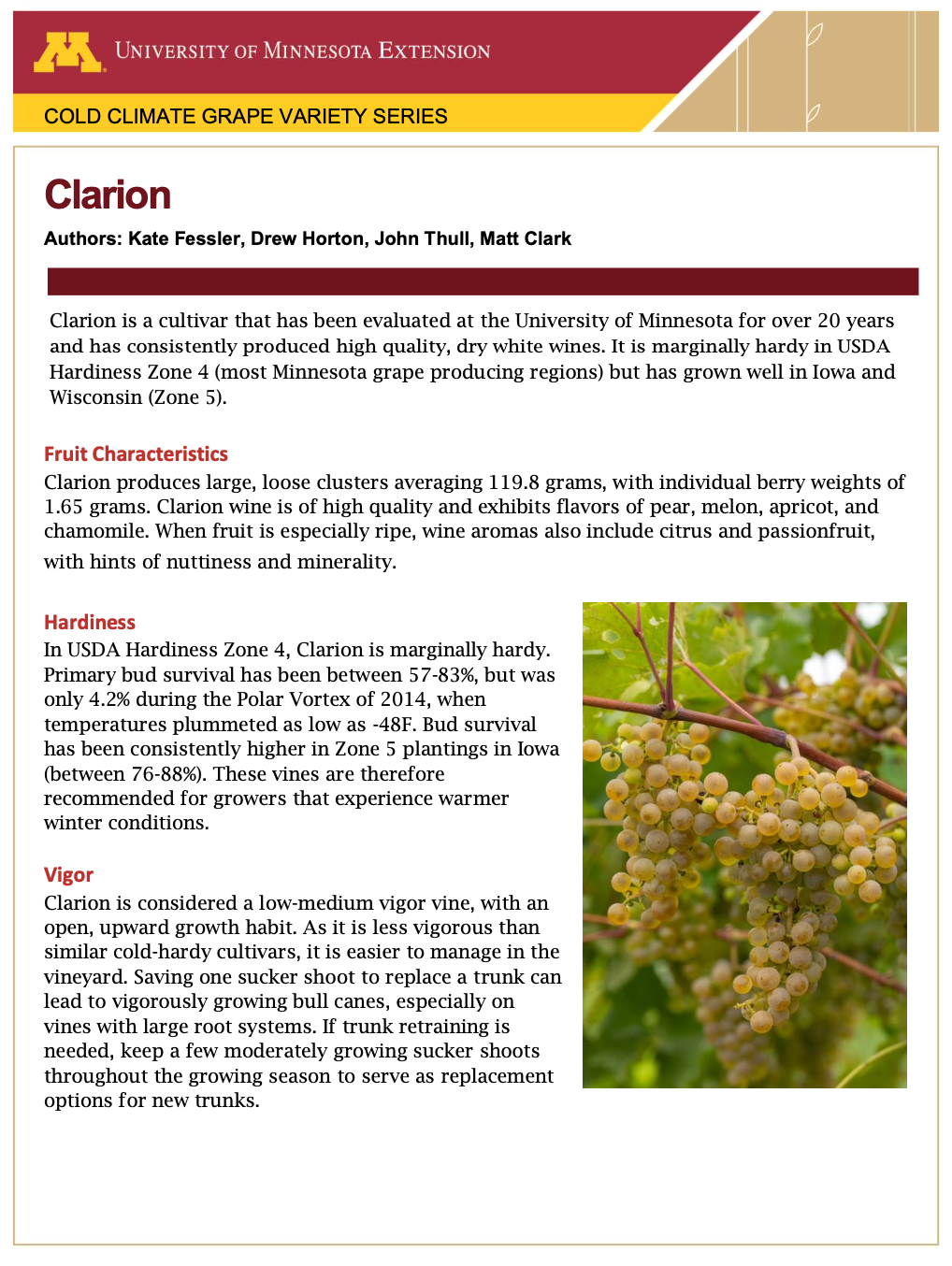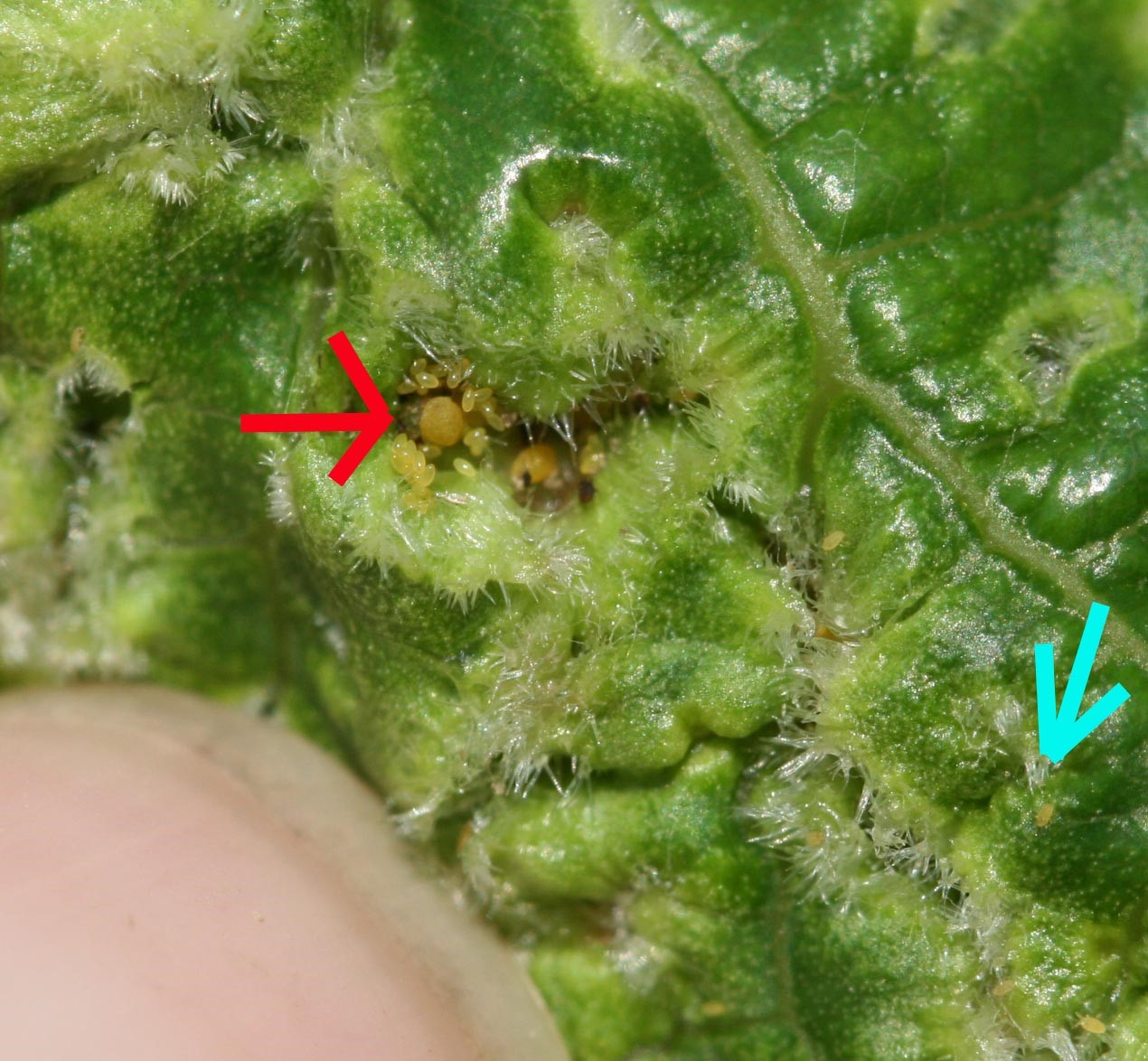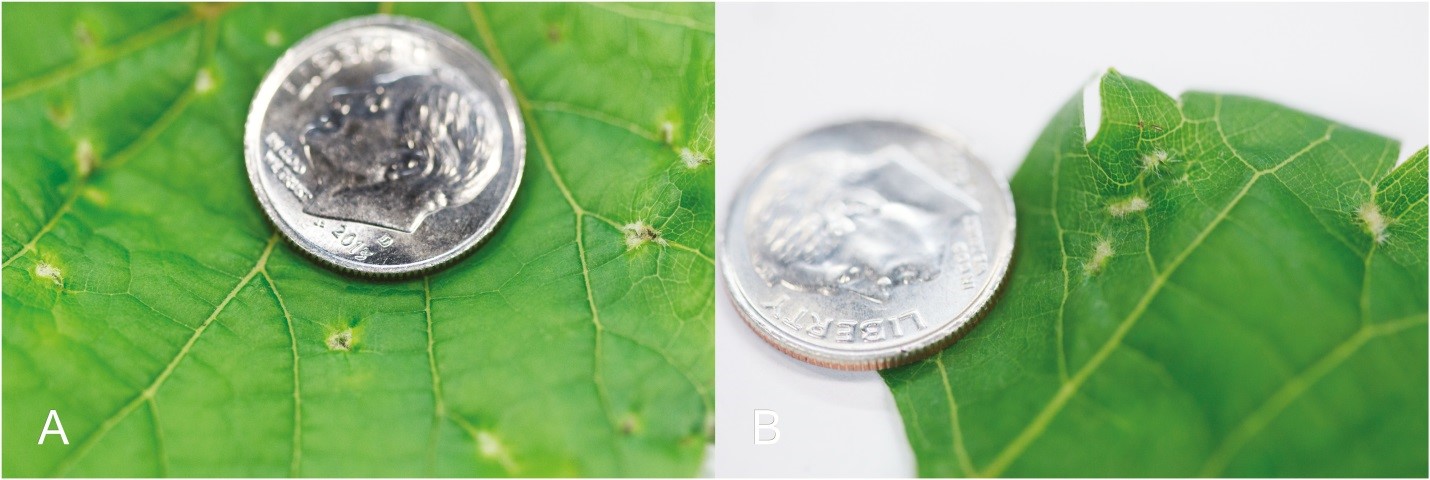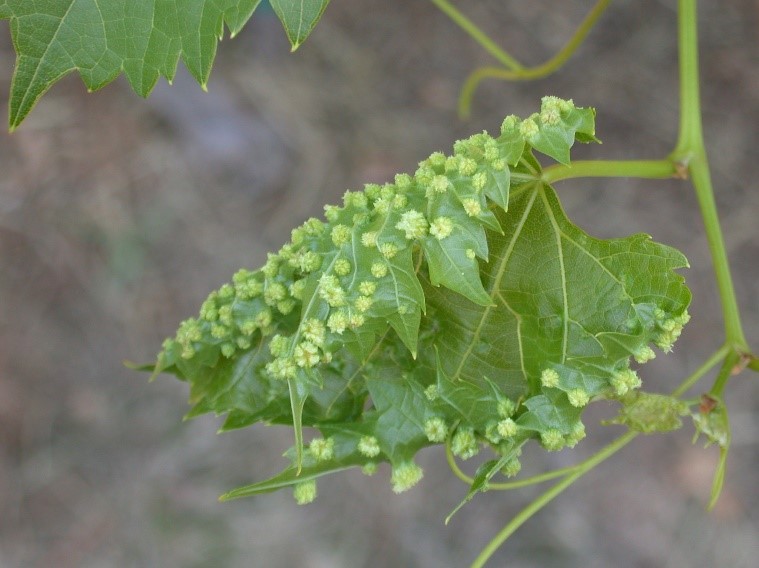
Welcome to the Grape Breeding and Enology project website
Located at the University of Minnesota-Twin Cities, we conduct research in the Department of Horticultural Science and at the Horticultural Research Center. Our focus is on grapevine cultivar development which includes: wine grapes, table grape varieties, and ornamentals that survive and thrive in cold-climate conditions. We also work on understanding the mechanisms of disease and pest resistance so that we can incorporate these traits as a way to improve sustainability for Minnesota growers. In addition to breeding grapes, we develop and teach enology best practices for cold-hardy grapes.
Ask for Clarion!
By Kate Fessler, Drew Horton, John Thull, and Matt Clark
We have developed a short guide for our most recent UMN release, 'Clarion'! This high quality white wine cultivar is hardy to USDA Zone 5. Click on the preview below to open the PDF, or at the following link: Link to Clarion fact sheet.

News
Practical Tips for Managing Grape Phylloxera in Minnesota
Bill Hutchison1, Eric Burkness1, Lu Yin2 & Matt Clark3
1Dept. of Entomology, Extension IPM Program, 2Graduate Student, Dept. of Horticultural Science, & 3Dept. of Horticultural Science & UMN Extension, University of Minnesota
The foliar form of Grape Phylloxera (GP) is quite common throughout Minnesota and most eastern grape growing regions of the U.S. Although we have experienced a late spring so far this year, the first grape leaves for most hybrids have started to appear; this is a good time to begin monitoring for the “yellow crawler” stage of GP, as the crawlers hatch from their “mother” galls (including a female with several eggs, Fig. 1).
Grape Phylloxera Life Cycle
In brief, the GP life cycle is quite complex, with galls formed on both root and foliar portions of the vine. However, given the genetic background of the cold-hardy grape hybrids in the Midwest region, the primary potential for damage is the presence of foliar galls formed by GP. Much of this information is taken from a recent publication by one of our graduate students in Horticultural Science, Lu Yin (Yin et al. 2019; see full citation below).

Figure 1: Mature grape phylloxera female and eggs (indicated by red arrow) and crawler (blue arrow) on a young grape leaf (Hannah Burrack, NC State).
Following the hatch of overwintered eggs (on trunk of vine), typically in early May (though later this year), the first-generation nymphs, or “crawlers” move to the grape shoots to feed on 1st to 3rd expanding terminal leaves. The leaf forms a gall around each crawler; at this time the crawlers will form less than 5 galls/leaf. During May-June, each crawler matures within the gall (Fig. 1) and will produce 100-300 yellow, oblong eggs. The subsequent emergence of young 2nd generation crawlers (Fig. 1) will begin, and crawlers will move out from the “mother gall”, to establish new galls on new leaves during the summer months (Fig. 2 and 3).

Figure 2: Fig. 2. Early pin-sized galls (open), and mature foliar galls (closed), Grape Phylloxera, MN (Lu Yin, Univ. of Minnesota).

Figure 3: Mature foliar galls formed by Grape Phylloxera crawlers (E. Burkness, Univ. of Minnesota).
Scouting and Management
The crawlers that hatch from the mother eggs, are the most critical generation for timing a 1st insecticide application, early summer. These crawlers will walk up the plants to 5-6th open leaves, and generate 40-50 galls per leaf, common on susceptible varieties. Three or more generations can occur in MN depending on the year, with additional galls being formed throughout summer.
For timing, growers can use a degree-day (DD) or “heat unit” model to track the initial infestation rates of crawlers. Degree-days for GP are calculated from the bio-fix date (time at which 1st leaves unfurl) by the following: DD = Average daily temperature – 43F, and accumulate DDs each day. The 2nd generation crawler emergence period occurs at 500-800 DDs; in MN we recommend to start scouting at 450 DDs, and twice weekly when possible.
Regarding insecticidal control, the two most common options used in MN have been Danitol (pyrethroid) and Movento (systemic). To minimize the risk of resistance, these can be alternated (via different modes of action). In most years, only one spray for GP is necessary, or a maximum of 2 sprays.
With Movento, on recent on-farm trials, we have found that one application is often sufficient. After the first spray, check again for any additional gall formation instead of assuming an automatic 2nd spray is needed. As with other crops, sprays should ideally be applied during the evening hours to minimize the risk of direct contact, and mortality to bees and pollinators. Prior to any insecticide use, the label should be reviewed carefully to follow all application safety and use requirements. For more information, review the 2019 Fruit Pest Management Guide (cited below). Finally, in recent years, for some MN vineyards, we have noticed that once GP has been controlled (1 or 2 sprays), it may take up to 2 additional years for the pest population to re-establish, at least at high levels. Bottom-line: to monitor vineyards each spring/summer to verify low or high infestations via the presence of early galls.
More Information
For more information on insecticide options for managing GP, see the 2019-2020 Midwest Fruit Pest Management Guide, at: https://ag.purdue.edu/hla/Hort/Documents/ID-465.pdf
For more information on the history and biology of grape Phylloxera in the U.S., click here for the open access article by Lu Yin et al. (2019), https://academic.oup.com/jipm/article/10/1/16/5490144
For additional Fruit Insect IPM updates, see: www.fruitedge.umn.edu
Herbicide Recommendations for New Grapevine Plantings
Author: Annie Klodd, Extension Educator. [email protected].
When planting new grapevines, a strong weed management plan is essential to growing healthy, vigorous, and productive vines. Young vines do not compete well with weeds. Dense weeds in the establishment year will dramatically stunt the growth of the vines and have long term effects like making them weaker, slower to produce a crop, and more susceptible to winter injury.
A well-planned herbicide program allows strong weed control without disturbing the soil and tender grapevine roots. Mechanical weeders such as a weed badger around the vines can cause extreme stress on the young vines, since most grapevine roots are in the top few inches of the soil and are damaged by mechanical weeders. Mowing or weed wacking is a good weed control option for established vineyards, but still allows a high risk of root competition with young vines, especially if perennial grasses are present. Therefore, it is good practice to use an herbicide program on first-year vines unless the vineyard is organic (stay tuned for another article on recommendations on organic weed control for vineyards).
The basic steps to herbicide management in the year of planting include:
- Making the rows weed-free before planting, with post-emergent herbicide (and pre-emergent herbicide when appropriate)
- Placing grow tubes around the vines in order to spray without injuring the vines
- Applying a pre-emergent herbicide after planting to suppress weed germination
- Applying post-emergent herbicides as needed to maintain weed-free rows the entire season
Herbicides should be selected based on the weeds in the field. Apply them only to the ground with a directed or shielded sprayer to minimize drift onto the vines, and always follow label instructions.
Before planting, clear all vegetation from the rows in a 2 foot wide strip where the vines will be planted. This can be done either with post-emergent herbicides, or by tilling in strips.
After planting, the vine rows must be kept free of weeds during the whole season. Put grow tubes on the vines after planting, in order to protect the vines from in-season herbicide sprays.
Controlling weeds before planting
Post-emergent (POST) herbicides are the most common form of weed control prior to planting. Apply the POST herbicide once the grass is actively growing (more than 4 inches of green growth). POST herbicides are not effective on dormant weeds. A pre-emergent product may sometimes be used following the POST, if timing safely allows.
Allow a few days between POST herbicide application and vine planting, in order to avoid herbicide injury to the vines. In order to determine how much time to allocate between application and planting, check the herbicide product restrictions and re-entry intervals (REI) on the label, and in the Midwest Fruit Pest Management Guide. As always, the label is the law.
Selecting pre-plant POST herbicides: Often, the natural vegetation growing in the field before planting will be a mix of perennial and annual grasses, with some broadleaf weeds. In these cases, it is very important to use full rates of herbicides that have strong activity on perennial grass. Beyond that, select herbicides based on what types of weeds are in the field.
Example 1: If a fallow field has a large amount of perennial grass and broadleaf weeds (such as pigweed and lambsquarter), use an herbicide that has good activity on both grasses and broadleaves or apply multiple herbicides to meet your needs (options below). Example 2: If the field has been in an annual grass cover crop and no broadleaf weeds are present, it is not as necessary to use a product with broadleaf effectiveness. If the field has little to no perennial grass, a product with strong activity on annual grasses can be used even if its activity on perennial grass is weak.
Post-emergent (POST) herbicides to use before planting
Below is a selection of herbicides with strong effectiveness against grasses, and many have broadleaf effectivness as well. For more details on how to apply these products, refer to the Midwest Fruit Pest Management Guide and the product label.
- Glyphosate (i.e. Roundup WeatherMax 5.5EC): Effective on a broad range of perennial and annual grass, and broadleaves. Use a high rate for perennial weeds, within the label restrictions. Can be tank mixed with labeled pre-emergent herbicides.
- Fusilade DX 2EC (fluazifop): Effective on most annual and perennial grasses. Do not exceed 24 fl. oz. per application per acre, or 72 fl. oz. per acre per year. Allow 14 days between applications. This product is best to apply early in the season, as it has a 50 day pre-harvest interval (PHI).
- Select Max (clethodim): Effective on most annual and perennial grasses, but no activity on broadleaves. This product can only be used on non-bearing vines, meaning those that will not be harvested within one year of application. If broadleaf weeds are present, combine Select Max with another herbicide with broadleaf activity such as Aim 2EC or Goal 2XL.
- Scythe 4.2E (pelargonic acid): Effective on a broad range of annual grasses and broadleaves, with some activity on perennial grasses. Use a high rate for perennial grasses or winter annual weeds, and a lower rate for summer annual weeds.
- Rely 280 (glufosinate): Effective on annual and perennial grasses and broadleaves. Use care when applying this product, making sure to direct the spray to the ground and to not spray during windy conditions; if glufosinate drifts on to the grapevine foliage it may cause significant injury.
- Gramoxone: Effective against annual grasses and broadleaves, but not perennial grasses. Will not kill perennial grasses, only burn the tops. This is a Restricted Use Pesticide and therefore requires the applicator to have a Private Pesticide Applicator’s License.
- This information is based on the Midwest Fruit Pest Management Guide
Applying pre-emergent (PRE) residual herbicides before planting
First, what is a pre-emergent herbicide? As opposed to post-emergent (POST) herbicides, which kill actively growing weeds, pre-emergent (PRE) herbicides are applied to bare soil to stop new weed seeds from germinating.
Applying a PRE product before planting is an optional step, and may not be logistically possible in all years depending on weather and time constraints. When possible, the advantage of applying a PRE herbicide before planting is to prevent new weed emergence for several weeks, reducing the need for frequent POST applications later on.
Why is a pre-plant PRE herbicide logistically difficult? First, most of the PRE herbicides for vineyards have age restrictions and cannot be applied before planting or to vines less than a year old. Some have age restrictions of several years. Prowl H2O is one of the only PRE herbicides that can be safely applied before planting vines. Additionally, most PRE herbicides must be applied to bare ground only; the ground should not have vegetative cover in the form of turf or weeds, or the product will have trouble reaching the soil where it is effective. This means the grower can only apply a PRE after they have applied the POST, and the weeds have died down completely. Because it sometimes takes days for weeds to die down after a POST, a grower may not have time to apply both a POST and PRE herbicide before planting.
How and when to apply Prowl H2O (pendimethalin) before planting: Before applying Prowl, apply a POST herbicide to the rows to kill existing weeds. Wait until the weeds have died to the ground, and then apply Prowl. Following the range of allowable rates on the label, apply a high rate to ensure good weed control. It may be either incorporated with tillage or applied to the surface. Rain or watering is needed within 21 days in order to activate the compound. Do not allow the spray to touch nearby vines that have broken bud.
Weed management after planting
After planting, maintain weed control throughout the season in order to prevent competition with the newly established vines. This should be done with a combination of PRE and POST herbicides in the rows (two-foot strip), and mowing between the rows. A good PRE application early in the season will decrease the number of POST applications that are necessary, because fewer weeds will emerge from the soil.
Grow tubes: In order to apply herbicides without injuring or killing the young vines, secure grow tubes around the vines and keep them there for the entire first season.
Pre-emergent herbicide application after planting
Pre-emergent herbicide options are limited for newly planted vines, but there are several products that can be applied after planting, as long as a grow tube is used to protect the vine. Many products specify that they can only be applied to dormant vines, which means they cannot be applied after bud swell. However, if the vines are protected by a grow tube, the PRE can be sprayed later in the season without damaging the buds.
The timing of PRE applications is important. The ground should be as weed-free as possible when PRE herbicides are applied, and the soil should have settled after planting and have no cracks. The chemical needs to reach the soil in order to work. Weeds growing there will intercept some of the product before it can reach the soil, decreasing the product’s effectiveness. Therefore, if many weeds are growing, apply a POST product to clear the soil before applying a PRE.
Additionally, wait to apply a PRE until the soil has settled after planting. If cracks remain in the soil from planting, PRE application could injure the grapevine roots. In the meantime, apply a POST product to remove any early season weeds that have emerged.
PRE options for the establishment year, after planting, include:
- Prowl H2O (pendimethalin): Annual grasses and some broadleaves. Apply once the ground has settled post-planting and has no cracks. Needs rain within 21 days to be effective.
- Snapshot 2.5TG (isoxaben and trifluralin): Annual grasses and some broadleaves. Apply once the ground has settled and has no cracks. Can only be used on non-bearing vines that will not be harvested within 1 year. Rain or watering (0.5 inches) is needed within 3 days of application. Wait 60 days between applications. Rate is 100-200 lbs/acre.
- Devrinol 2-XT (napropamide): Annual grasses and broadleaves. Apply in spring or late fall at a rate of 2 gal/acre. It can be tank mixed with a POST herbicide.
- Surflan 4AS (oryzalin): Annual grasses and some broadleaves. Apply alone or tank mix with glyphosate or gramoxone, depending on the weeds in the field (see POST table). It will not activate until 0.5 inches of rain has fallen. Wait 2.5 months between applications. Apply 2-6 qts. In 20-40 gallons of water, depending on weed severity, not exceeding 12 qts/year.
- Treflan HFP 4EC (trifluralin): Annual grasses and broadleaves. Must be incorporated with tillage, which makes this option difficult in many cases. In a new planting, apply 1-4 pts/acre and incorporate within 24 hours. 60-day pre-harvest interval (PHI).
- Trellis (isoxaben): Annual and perennial broadleaf weeds. Apply between 0.67-1.33 lbs/acre in a minimum of 10 gallons of water. As with others, apply before weeds germinate.
Post-emergent herbicide application after planting
Post-emergent herbicide options after planting include those listed above as well as those in the below table. Additionally, the Midwest Fruit Pest Management Guide includes an extensive list of herbicide options along with the rates, pre-harvest intervals, re-entry intervals, and relative effectiveness of each product on grasses and broadleaf weeds.
Use a grow tube on the vines in order to safely apply herbicide to new vines.
The timing of POST applications is important as well. During the growing season, target weeds with POST herbicide when they are young and growing rapidly. As weeds become more mature, they are more resilient to herbicides. Many weed scientists recommend the “Pop can method” for determining the height at which weeds should be sprayed. For many broadleaf weeds, the rule of thumb is if the weed is taller than a pop can, it may be too tall and strong to be completely killed by herbicides when applied at legal rates. While this is a broad generalization, it seems to hold true for a number of broadleaf species.
POST herbicide options for grapes (taken from the Midwest Fruit Pest Management Guide, pages 153-154)
